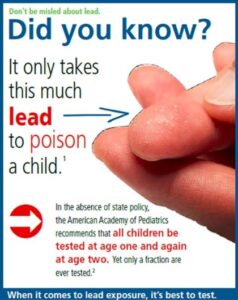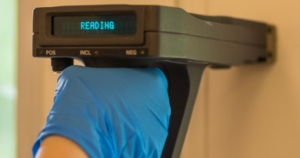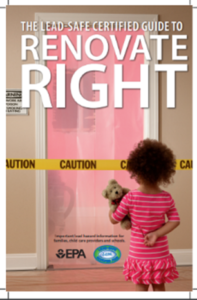 Lead is a metal that can harm children when it gets into their bodies. Lead can harm a young child’s growth, behavior, and ability to learn. It can also cause anemia, kidney damage, and hearing loss. There are many sources of lead. Lead can be found in dust, air, water, soil, and in some products used in and around our homes. Lead paint dust and lead paint chips being breathed in or ingested by children is the number one source of childhood lead poisoning. Click here for more details about lead poisoning.
Lead is a metal that can harm children when it gets into their bodies. Lead can harm a young child’s growth, behavior, and ability to learn. It can also cause anemia, kidney damage, and hearing loss. There are many sources of lead. Lead can be found in dust, air, water, soil, and in some products used in and around our homes. Lead paint dust and lead paint chips being breathed in or ingested by children is the number one source of childhood lead poisoning. Click here for more details about lead poisoning.
 A blood lead test is the easiest way to find out if a child has been exposed to lead. Most children with lead in their blood have no obvious symptoms. Children enrolled in Medicaid should be tested at ages 12 and 24 months. If a child may have been exposed to lead, the child’s parent or caregiver should talk to their health care provider about getting a blood lead test. Lead blood testing is also available at the Clark County Combined Health District and the appointment only takes 20 minutes. Lead blood testing is free for Medicaid recipients and many private insurance policies cover the cost. To learn more about lead blood testing and to schedule a lead blood test for you or your child, call 937-390-5600 or visit our Lead Testing page.
A blood lead test is the easiest way to find out if a child has been exposed to lead. Most children with lead in their blood have no obvious symptoms. Children enrolled in Medicaid should be tested at ages 12 and 24 months. If a child may have been exposed to lead, the child’s parent or caregiver should talk to their health care provider about getting a blood lead test. Lead blood testing is also available at the Clark County Combined Health District and the appointment only takes 20 minutes. Lead blood testing is free for Medicaid recipients and many private insurance policies cover the cost. To learn more about lead blood testing and to schedule a lead blood test for you or your child, call 937-390-5600 or visit our Lead Testing page.
Parents and caregivers should find out the year their home was built. In homes or buildings built before 1978, assume that the paint contains lead unless tests show otherwise. Don’t forget to consider any place your child spends six hours or more in a week, such as a grandparent’s or daycare provider’s home. Parents and caregivers should also find out the year when that place was built. While lead paint dust and lead paint chips breathed in or ingested by children is the number one source of childhood lead poisoning, lead contaminated soil around older buildings, either from exterior paint or vehicle emissions is the second.
find out the year their home was built. In homes or buildings built before 1978, assume that the paint contains lead unless tests show otherwise. Don’t forget to consider any place your child spends six hours or more in a week, such as a grandparent’s or daycare provider’s home. Parents and caregivers should also find out the year when that place was built. While lead paint dust and lead paint chips breathed in or ingested by children is the number one source of childhood lead poisoning, lead contaminated soil around older buildings, either from exterior paint or vehicle emissions is the second.
Parents or caregivers can take the following additional steps to protect their family from lead exposure:
• Talk to the child’s health  care provider about getting a blood lead test. A blood test is the easiest way to determine if a child has been exposed to lead. The Clark County Combined Health District (CCCHD) can provide capillary finger-prick or heel-prick lead tests for children and adults. Appointments are necessary and only take 20 minutes.
care provider about getting a blood lead test. A blood test is the easiest way to determine if a child has been exposed to lead. The Clark County Combined Health District (CCCHD) can provide capillary finger-prick or heel-prick lead tests for children and adults. Appointments are necessary and only take 20 minutes.
• Wash children’s hands, bottles, pacifiers, and toys often.
• Ensure children eat nutritious meals high in iron, calcium, and vitamin C. • Get your home checked for lead hazards including lead based paint if it was built before 1978. Renters should ask their landlord to have the home checked for potential lead sources. Testing for lead paint is available by hiring an Ohio Department of Health licensed lead safe service provider or by using a home test kit. (Note: home test kit results are less reliable than using a licensed professional).
• Get your home checked for lead hazards including lead based paint if it was built before 1978. Renters should ask their landlord to have the home checked for potential lead sources. Testing for lead paint is available by hiring an Ohio Department of Health licensed lead safe service provider or by using a home test kit. (Note: home test kit results are less reliable than using a licensed professional).
• Test your water for lead. Contact your utility to see if you are eligible to participate in their compliance sampling or contact an Ohio EPA certified lab to test for lead in your water. If there is lead, take steps necessary to reduce or eliminate exposure. Click here to learn about the City of Springfield’s Lead Service Line Replacement Assistance Program.
• Use only approved methods for removing lead hazards if you are a do-it-yourselfer (DYI) or hire an Ohio Department of Health licensed lead safe service provider.
• Fix surfaces in the home that have peeling or chipping lead based paint. Click here for information on completing repairs and renovations safely. Renters should talk to their landlord about fixing this.
• Use wet cleaning methods to clean floors, windowsills, and other surfaces and take precautions to avoid lead dust when remodeling.
• Remove shoes or wiping soil off shoes before entering the house.
off shoes before entering the house.
• Plant grass on areas of bare soil or cover the soil with grass seed, mulch, or wood chips, if possible. Until the bare soil is covered, move play areas away from bare soil and away from the sides of the house.
• Do not grow fruits or vegetables in lead-contaminated soil. Using a container garden is a good alternative.
There is no cure for lead poisoning, but parents and caregivers can help reduce the harmful effects of lead  exposure by talking to their doctor and getting connected to learning, nutritional, and behavioral programs as soon as possible. That is why preventing exposure to lead, especially among children, is important. Finding and removing sources of lead from the child’s environment is needed to prevent further exposure. The goal is to decrease the amount of lead in the blood as quickly as possible to reduce the effects.
exposure by talking to their doctor and getting connected to learning, nutritional, and behavioral programs as soon as possible. That is why preventing exposure to lead, especially among children, is important. Finding and removing sources of lead from the child’s environment is needed to prevent further exposure. The goal is to decrease the amount of lead in the blood as quickly as possible to reduce the effects.
In Clark County, the Clark County Combined Health District has a Lead Case Manager who works with families of lead-poisoned children as well as pregnant and breastfeeding women. The Lead Case Manager works closely with the Ohio Department of Health to collect and share information regarding lead exposures and medical management and works with the individual and family to develop a plan of care that includes conducting a risk assessment, providing education and resources, and follow-up blood work as needed until the amount of lead in the blood decreases to below 5 ug/dL. For more information on the recommended follow-up and case management for children with lead in their blood, refer to CDC’s Recommended Actions Based on Blood Lead Level.
Children under 6 years of age are at greatest risk for health problems caused by lead exposure. This is because their bodies are still developing and growing so rapidly. Young children also tend to put their hands or other objects, which may be contaminated with lead dust, into their mouth.
are at greatest risk for health problems caused by lead exposure. This is because their bodies are still developing and growing so rapidly. Young children also tend to put their hands or other objects, which may be contaminated with lead dust, into their mouth.
Any child can be exposed to lead. However, some groups of children are at higher risk, including children who:
• Live or spend time in homes built before 1978, especially those with paint that is chipping, peeling, or in poor condition.
• Live in pre-1978 housing with recent, ongoing, or planned renovation or remodeling.
• Are in households with incomes below the federal poverty level.
• Are members of racial-ethnic minority groups that have been economically/socially marginalized.
• Are recent immigrants from countries with lead in the environment.
• Have siblings, housemates, or playmates with known lead exposure.
• Have parents or household members who are exposed to lead at work or through a hobby.
• Live near active lead and other types of smelters, battery recycling plants, or other industries that release lead into the air.
• Old painted surfaces, paint chips and dust
• Bare soil along roof driplines
• Antique artifacts with lead based paint or lead based glaze
• Certain occupations/hobbies dealing with paint (pottery, auto repair, etc.)
• Contaminated drinking water
• Certain folk or home remedies, cosmetics, toys, and jewelry
• Remodeling of older homes containing lead based paint
• Foreign-manufactured products
• Occupations dealing with lead
• Cigarettes and cigarette smoke
Additional lead exposure sources information is available here and information about lead found in food, foodwares, and dietary supplements is available here.
Thankfully, Springfield has very low to zero lead exposure in its water systems as demonstrated by this link to the Water Treatment Plant Consumer Confidence Report. If a Springfield resident has a lead service line, the city offers a Lead Service Line Replacement Assistance Program. Click on the following jurisdiction names for information on lead levels in their water supplies: North Hampton, New Carlisle, Park Layne,
South Charleston, and Enon. For jurisdictions not listed, please contact your local water treatment facility and/or local government.
Lead-safe certified contractors can safely renovate houses and other buildings. The United States Environmental Protection Agency’s (EPA) Lead Renovation, Repair and Painting Program describes steps contractors can take to safely renovate homes built before 1978. A certified risk assessor can help decide whether abatement (eliminating lead hazards completely) is a better option. To find an Ohio Department of Health (ODH) lead safe service provider click here to access ODH’s searchable database with the name and contact information of all licensed lead safe service providers in Clark County and all of Ohio. Do-it-yourself homeowners click here to learn how to keep your family safe from lead exposure when doing renovation, repair, and painting work at home
contractors can safely renovate houses and other buildings. The United States Environmental Protection Agency’s (EPA) Lead Renovation, Repair and Painting Program describes steps contractors can take to safely renovate homes built before 1978. A certified risk assessor can help decide whether abatement (eliminating lead hazards completely) is a better option. To find an Ohio Department of Health (ODH) lead safe service provider click here to access ODH’s searchable database with the name and contact information of all licensed lead safe service providers in Clark County and all of Ohio. Do-it-yourself homeowners click here to learn how to keep your family safe from lead exposure when doing renovation, repair, and painting work at home